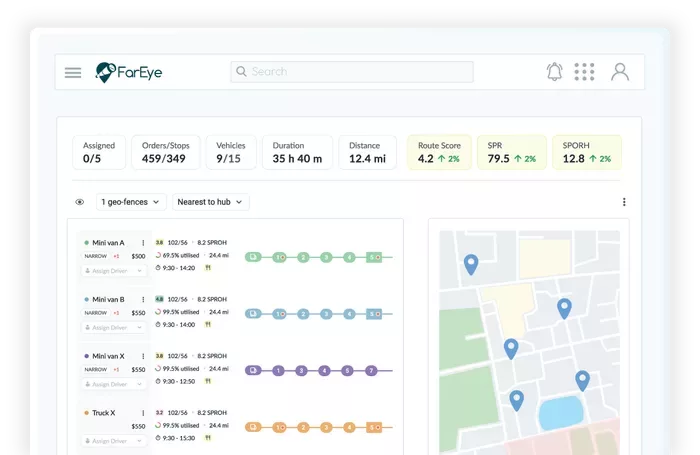- Delivery Routing
Delivery Routing Software: Supporting On-time Deliveries and Customer Satisfaction
Table of Contents
- Why Reliable Routing Matters for Every Delivery
- What Makes Delivery Route Planning Software Indispensable?
- Route Planning and Optimization: The Backbone of Fleet Efficiency
- The Impact of Delivery Route Optimization Software and Real-time Dynamic Routing
- Optimizing Delivery Windows for Customer Satisfaction
- Integrating All-in-one Routing with the Supply Chain
- Integration & Data Requirements
- AI-Driven Insights and Machine Learning: The Next Frontier
- Measuring Success: Business Impact and Real Results
- The Road Ahead: Delivering Reliability and Loyalty at Scale
- FAQs

Every year, delivery expectations shift and delivery routing software plays a crucial role in meeting them.. Customers don’t just want their parcels quickly; they want them precisely when promised, tracked at every step, and delivered with minimal fuss. E-commerce sales in the first quarter of 2025 accounted for 16.2% of total sales in the US, highlighting the growing influence of digital commerce on delivery volumes.
As businesses face surging order numbers, they are rethinking their approach to routing and last-mile performance. The pressure is real: meeting tight delivery windows, maximizing fleet efficiency, and sustaining customer loyalty are now strategic imperatives, not simply operational targets.
Against this backdrop, many of the industry’s most forward-thinking organizations are investing in advanced delivery routing software to close the gap between what’s expected and what’s possible.

Why Reliable Routing Matters for Every Delivery
Precise delivery is more than a convenience; it’s a core differentiator in a fiercely competitive landscape. For dispatchers and fleet allocators, the challenge is clear: orchestrate hundreds or thousands of deliveries daily while balancing cost, compliance, and service quality.
Relying on spreadsheets or manual planning is no longer sufficient. Small inefficiencies in route planning ripple outward, leading to missed time slots, unhappy customers, and spiraling costs.
This is where modern delivery route planning software comes into play, reshaping what’s possible for businesses striving for predictable, high-quality deliveries at scale.
What Makes Delivery Route Planning Software Indispensable?
Let’s start with the fundamentals. Delivery routing software is engineered to find the smartest, fastest way to move goods from distribution centers to doorsteps, shops, or business locations. Unlike traditional methods, today’s platforms use real-time data, AI, and machine learning to continually refine every step of the delivery process.
The best solutions analyze traffic, weather, vehicle capacity, driver schedules, and dozens of other constraints to create optimized, executable routes, reducing wasted miles and improving on-time delivery rates. Delivery route planning software goes further, blending predictive analytics with dynamic rerouting and tailored compliance for each region or customer segment.
In short, delivery routing software is no longer just a back-office tool. It’s the brain behind modern logistics, aligning customer promise with operational capability.
Route Planning and Optimization: The Backbone of Fleet Efficiency
Efficient fleet management begins with delivery route planning software. The ideal platform does more than chart a course; it adapts on the fly, responding to live variables such as order changes, cancellations, and urgent requests. The difference between good and great is measurable:
- Route optimization algorithms maximize stops per hour and minimize driving time.
- Constraints like vehicle type, shift duration, service requirements, and compliance (e.g., DoT regulations) are considered for every assignment.
- Dynamic adjustments enable dispatchers to reallocate loads, handle late-breaking changes, or insert urgent deliveries without derailing the day’s plan.
Delivery routing software leverages proprietary AI algorithms to generate routes for thousands of orders in minutes, factoring in 100+ constraints for each scenario. The result? Higher utilization, lower operational costs, and a platform that scales effortlessly as business grows.
The Impact of Delivery Route Optimization Software and Real-time Dynamic Routing
No two days are the same for a delivery operation. Real-time dynamic routing, powered by AI and machine learning, is transforming how fleets respond to unpredictable variables. Whether it’s traffic congestion, weather disruptions, or last-minute customer changes, the right delivery route optimization software reacts instantly.
Delivery route optimization software offers:
- Live GPS Tracking: Dispatchers and drivers always know the best path, adapting to road closures or detours in real time.
- Predictive Service Times: AI predicts how long each stop will take, using historical data to sharpen scheduling accuracy.
- Intelligent Load Balancing: The system reallocates orders or merges loads to prevent missed windows and reduce empty backhauls.
These features are not just conveniences; they’re critical levers for protecting both cost and customer promise.
Optimizing Delivery Windows for Customer Satisfaction
One of the greatest sources of customer frustration is missed or vague delivery windows. Modern routing platforms solve this by:
- Offering dynamic delivery slots that match real-world capacity and fleet location.
- Factoring in customer preferences and territory-specific considerations.
- Using predictive analytics to propose green window time slots that minimize cost and carbon emissions while meeting customer needs.
Delivery route optimization software nudges customers to select more sustainable delivery windows at checkout, incentivized by lower costs or rewards. The result is a higher first-attempt delivery success, fewer failed drops, and a more personalized experience.
Integrating All-in-one Routing with the Supply Chain
Seamless integration is non-negotiable for high-volume delivery operations. Today’s leading routing solutions connect with order management systems (OMS), transportation management systems (TMS), customer relationship management (CRM), and real-time visibility platforms.
Benefits include:
- Automated Order Imports: No manual data entry, fewer errors, and faster dispatch.
- Unified Dashboards: Dispatchers monitor every order, driver, and vehicle in one place.
- End-to-end Visibility: Customers and stakeholders track deliveries from the warehouse to the doorstep.
FarEye’s plug-and-play routing APIs enable instant route optimization directly from your existing tech stack, reducing deployment time and ensuring data flows smoothly across all systems.
Integration & Data Requirements
To unlock accurate metrics and smooth routing performance, delivery routing software typically connects with:
- OMS/TMS for order and transport data
- Telematics/vehicle feeds for location and utilization
- Driver app GPS for live tracking and navigation
- Customer notification channels (SMS, email, WhatsApp) for status updates
- Proof-of-delivery systems for validation and compliance
This ensures data flows seamlessly, reducing errors and giving dispatchers and customers real-time confidence in every delivery.
AI-Driven Insights and Machine Learning: The Next Frontier
Artificial intelligence and machine learning have redefined what’s possible in route planning. FarEye’s AI-powered routing engine is designed to continually learn from day-to-day challenges, enabling smarter planning and measurable efficiency gains in typical client rollouts.
Some core benefits:
- Predictive Analytics: Identifies patterns in delays, high-traffic zones, and delivery exceptions, enabling continuous improvement.
- Smart Service Times: FarEye segmented service areas into micro-zones, dynamically adjusting expectations and improving scheduling precision.
- Rate-based Routing: Automatically selects the most cost-effective combination of owned, outsourced, and gig fleets for each route.
Over time, the platform’s recommendations become sharper, supporting dispatchers and allocators in making smarter, data-backed decisions.
Measuring Success: Business Impact and Real Results
For delivery leaders, the real measure of routing software is its impact on operations and customer experience.
KPI Dashboard: What to Measure
A single control-tower view helps leaders track the metrics that matter:
- On-time Delivery (OTD/OTIF): % of orders delivered within the promised time slot.
- First-Attempt Success Rate: % of parcels delivered without reattempts.
- Distance / Miles Saved: Planned vs. actual miles driven; reduction indicates optimization impact.
- Average Delivery Time: Total delivery hours ÷ number of stops.
- Driver Utilization: % of available driving hours productively used.
- Exception Rate: % of orders affected by delays, reschedules, or failed attempts.
Together, these KPIs give a clear view of cost, productivity, and customer promise at scale.
Advanced delivery route optimization software delivers results across multiple fronts. Typical client outcomes include:
- Productivity: Businesses report up to 15% increases in driver productivity and a 16% reduction in driving hours.
- Cost Reduction: Route optimization leads to savings of up to 20% in delivery costs, driven by fewer miles, less fuel, and better vehicle utilization.
- Capacity: AI-driven planning can lead to a 90% reduction in load planning time, freeing up teams to manage more orders with greater accuracy and fewer resources.
- Customer Satisfaction: Accurate ETAs, real-time updates, and reliable deliveries are proven drivers of loyalty and repeat business.
The Road Ahead: Delivering Reliability and Loyalty at Scale
The logistics industry is evolving rapidly, and expectations will only keep rising. Delivery routing software, especially solutions built on AI, real-time data, and scalable integration, offers businesses a proven way to deliver on their promises, control costs, and delight customers.
Your operation may handle parcels, food and grocery, large and bulky goods, or high-volume scheduled routes. FarEye is trusted by enterprises to improve on-time, customer-focused delivery, with typical client outcomes including higher first-attempt success rates and reduced planning hours. By investing in the right technology, organizations don’t just keep pace; they lead the way, turning every delivery into an opportunity for loyalty and growth.
FAQs
- What data do we need to start using delivery routing software?
Order details (SKU, quantity, service time), pickup/delivery addresses, time windows, vehicle capacities, driver shifts/skills, and business constraints (SLAs, priorities). Live traffic/telemetry improves accuracy. - How long does deployment typically take?
A pilot can go live in 4–8 weeks once data pipes and APIs are connected. A phased production rollout across regions usually takes 8–12 weeks, depending on volumes and integrations. - What ROI should we expect and when?
Teams commonly see miles/time reduced, higher first-attempt rates, and faster planning cycles within the first quarter post-pilot. Exact ROI depends on baseline efficiency, geography, and compliance constraints. - Does it support EV fleets and gig drivers?
Yes. Modern platforms handle EV-specific constraints (range, charge time, charger locations) and mixed capacity models, including owned, outsourced, and gig drivers with dynamic assignment.
Source:
https://www.census.gov/retail/mrts/www/data/pdf/ec_current.pdf

Komal Puri is a seasoned professional in the logistics and supply chain industry. As the AVP of Marketing and a subject matter expert at FarEye, she has been instrumental in shaping the industry narrative for the past decade. Her expertise and insights have earned her numerous awards and recognition. Komal’s writings reflect her deep understanding of the industry, offering valuable insights and thought leadership.
Let's Talk to Our Experts and Optimize Your Deliveries Today!
An expert from our team will reach out within 24 hours


